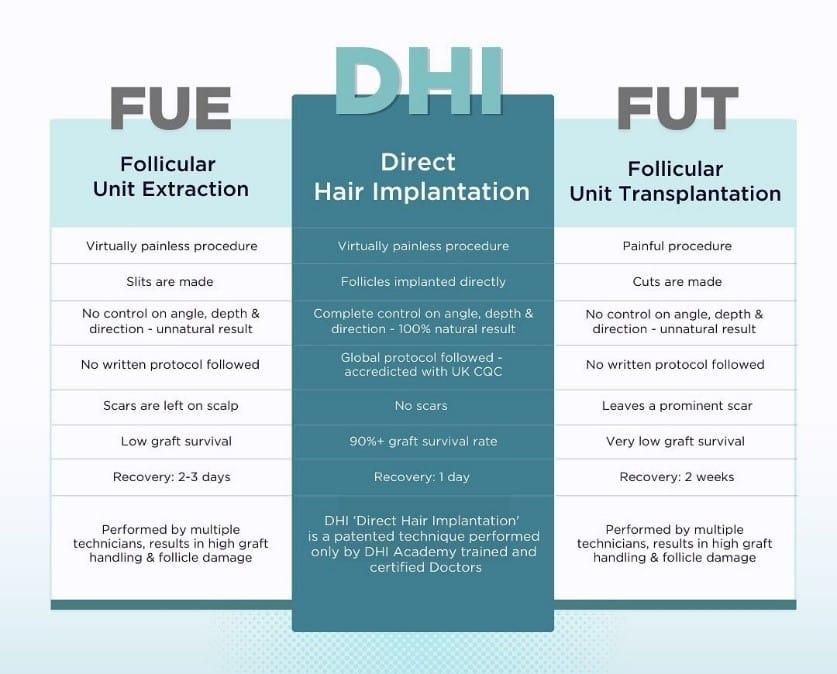DHI vs. FUE vs. FUT: Comparing Hair Transplant Techniques
The journey of attaining fuller hair growth by using the temporary hair loss solution has become easy due to the advancement in the healthcare segment. Besides, the optimal use of technology to stimulate hair growth painlessly is becoming popular all over the world. With the help of the latest technology, hair loss is being treated according to clients’ hairline restoration preferences.
To accentuate personality and achieve impressive personality, a hair transplant procedure is the ideal treatment to count on. Over the past few years, hair transplant procedures have been innovated keeping in mind, the risk factors, accuracy, and minimum pain involved in the surgery. To be specific, DHITM, FUE, and FUT are some of the popular hair transplant techniques that get tailored according to the hair restoration goals discussed during the hair loss consultation at the hair transplant clinics.
Hair Transplant Techniques
No matter which cause is specifically identified primarily by the hair transplant specialist, it becomes imperative to choose the best treatment. Keeping in mind, the advanced technologies and the hassle-free mechanism, choosing the top hair transplant clinic should be the foremost thing to reflect over. A hair transplant can rekindle the spark of confidence in a person’s approach by achieving the desired hairline. It is the fuller hair look that makes the personality of an individual charming, hence, choosing the best hair restoration procedure cannot be side-lined. At this point, it should be shared that among all the hair loss remedies or supplements, the surgical intervention is the most successful solution.

To be precise, knowing the types of hair transplant techniques is important to get the best results after the surgical procedure of hair restoration. As a major process, hair transplant moves hair follicles from one part of the body to the recipient area, i.e., the scalp. In the modern world of hair transformation surgical methods have their unique consideration and advantages. DHI, FUE, and FUT are among the common techniques used by the clinics to offer unmatched services of hair restoration. Let’s understand these procedures to reveal.
DHI, FUE, and FUT – Which Hair Transplant Technique Is Best?
-
Direct Hair Implantation (DHITM):
In the DHI hair transplant technique, follicles are implanted in the recipient area, directly. It is a most advanced hair transplant technique compared with the FUE technique, though, pre-made incisions are not required in the DHI hair transplant procedure. A special implanter tool is used in this hair transplant treatment method to achieve lifetime natural results with maximum density.
Direct Hair Implantation (DHITM) is a popular hair transplant patented technique executed in 45 countries in 75 clinics where the following processes are involved in hair restoration:
Extraction of Hair Follicles: As a part of this step in the DHI hair transplant technique, follicles are extracted from the patient’s scalp with the help of a micro punch tool. Generally, the donor area is usually at the back side of the head, since these areas are genetically resistant to hair loss and are called donor areas.
Segregation of Hair Follicles: Then the extracted follicles or grafts are kept in a tray and segregated into one’s, two’s three’s fours, and so on. So, surgeons will plan the hair implantation process to give natural-looking results and maximum density to the patient. In addition, patients have the transparency that how many grafts or hairs have been implanted in their scalp.
Implantation of Hair Follicles: One of the unique points to notice about the DHI technique is the method of extraction and then implantation of hair follicles and the process, transparency, and protocols, followed in the DHI clinics from starting to end are all unique. In this DHI hair transplant procedure, there are no incisions made in the recipient area before the implantation of the follicles. The implantation process is done by a DHI’s specialized implanter that has a hollow needle that can be between 0.8 to 0.9 millimeters, it is designed to maintain balance during the implantation with the help of DHI’s implanter, the DHI’s surgeon has amazing control over hair line and directions, always delivers natural-looking results. Whether it is related to controlling the depth, direction, or angle of implantation of the follicle, this tool plays an effective role in the execution of DHI hair transplant efficiently.
Minimally Invasive: The DHI hair transplant procedure is minimally invasive and gets executed without incision at the recipient area, and no stitches in the donor area. As a result, the recovery time and healing process are less with no risk of scarring after this surgical hair transplant procedure.
Customized & Natural Hairline Pattern: If you have been searching for an effective hair transplant technique that offers a natural-looking hairline, then, DHI is an ideal option to count on. Since the DHI’s implanter enables the surgeon to control the angle and density of each hair follicle’s placement, the customized hairline design can be attained after the DHI hair transplant procedure. The precision of the tool used in this hair transplant procedure plays a vital role in helping the surgeon attain the natural hairline design.
One-session hair transplant procedure: In most cases, it takes just a single session to complete the DHI hair transplant procedure for hair restoration treatment with customized hairline results. It solely depends on the number of hair follicles or grafts required and the patient’s tailored needs.
Furthermore, it should be mentioned to maintain safety and comfort throughout the DHI hair transplant procedure, local anesthesia is administered to the patient’s scalp. As an effect of the anesthesia, the patient stays in comfort and the surgeon can complete the hair extraction and implantation procedure efficiently. The DHI hair transplant procedure is very simple in that the patient can play games on mobile or watch TV in the OT room and get amazing natural results. Additionally, fuller hair growth can be witnessed after 8-12 months after the DHI hair transplant procedure.
-
Follicular Unit Transplantation (FUT):
FUT is the oldest used hair transplant technique which can also be denoted as the strip harvesting method. As a part of this technique, a strip of skin with hair follicles is removed from the back side of the scalp which is called the donor area. In the next step, the extracted strip is dissected into individual hair follicular units accurately while using the microscope. In addition, the incisions are marked in the recipient area with the help of a sharp blade to implant the follicular units without any mismatch. However, it should be noted that heavy scars may remain after the FUT hair transplant surgery on the donor side. But these scars may fade away when hair grows out after some time.
Steps involved in FUT hair transplant technique
- Consultation with the best hair transplant surgeon: Before finalizing the session of the FUT hair transplant procedure, you are recommended to seek consultation with a qualified hair transplant surgeon. As a part of the consultation process, the doctor will evaluate your hair loss pattern. He will also discuss your hair restoration objectives and determine your eligibility for the FUT hair transplant technique.
- Selection of the donor area: The back sides of the scalp where hair follicles are genetically resistant to balding are determined as the donor area for the hair transplant procedure. Since the transplanted hair retains its natural traits, this area is selected by the surgeon for FUT hair restoration.
- Local Anaesthesia: Surgeons ensure that local anesthesia is administered to the patient before starting the hair transplant surgery. This step is aimed at attaining numbness in the donor as well as the recipient areas. The patient’s comfort during the procedure is ensured through local anesthesia. However, patients feel pain during the hair transplant surgery.
- Donor Strip Harvesting: A strip of skin is removed from the donor area with the help of a scalpel by the hair transplant surgeon. Additionally, the required size and the length of the strip to be harvested are determined according to the individual’s needs. After the procedure, the wound is stitched or covered surgically for healing. The direct scarring may be noticed after the FUT procedure.
After the initial preparation of the FUT hair restoration procedure, dissection of the follicular units is carried out. The purpose of this step of the hair transplant technique, FUT is to isolate hair follicular units under a microscope. Moreover, the recipient site creation and graft placement along with the post-operative care are some of the steps that back this hair restoration procedure with customization and precision.
Reclaim Your Hair, Reignite Your Confidence! Begin your transformation today. Start Your Hair Revival Journey! Need help? Contact Us
Aspects that make FUT less effective over DHI, hair transplant procedure
From the linear scarring after the surgery, longer recovery time, and potential discomfort to the other complications of FUT, it is ideal to choose the DHI hair transplant technique for efficient and natural-looking results. In case, you are unsure about the relevance and accuracy of the two hair restoration techniques, then, consult with the certified, skilled, and experienced surgeons for the best advice. Most of all, it is the expertise, industry-wise exposure, and profound knowledge of the hair transplant specialist that will give you insights into the sure-shot results of the DHI hair transplant technique. The evidence-based prospects of the DHI hair transplant technique and complications of FUT can be discussed with the hair care specialist before actually finalizing the best hair transplant technique.
-
Follicular Unit Extraction (FUE):
This minimally invasive hair transplant technique involves the extraction of hair follicles from the area through a punch. At times, the robotic system may also be used to accomplish hair restoration goals through this technique. To start with the procedure, small and circular incisions are marked around each follicular unit. Due to this action of making incisions, linear scarring is visible. However, these scars are less than the ones witnessed after the FUT hair transplant technique. Apart from the above steps, the implantation of extracted hair in the recipient area is planned by the surgeon while marking tiny incisions with a sharp blade. It is worth mentioning that less discomfort and quicker recovery may be experienced as compared to FUT.
FUE hair transplant highlights
FUE hair transplant procedure involves donor area preparation by choosing the genetic hair loss-resistant area. The donor area hair gets trimmed according to the requirement for completing the FUE procedure of hair restoration. The next step is all about the extraction of hair follicles from the donor area with the help of medical punch tools. Typically, each follicular unit contains 1-4 hair strands which are used appropriately for graft placement. Before graft placement for hair growth experience, incisions are created by the hair transplant surgeon. In terms of healing and growth, the healing from the surgery will be noticed within a month, and hair growth can be experienced within 12-15 months.
DHI Vs FUE Vs FUT – Best Hair Transplant Technique with long-lasting results
On a comparative note, the DHI hair transplant procedure uses an advanced mechanism as compared to FUE and FUT hair transplant techniques. The Direct Hair Implantation (DHI) procedure is always performed by certified and trained surgeons only. But, in the case of the other two procedures, the technicians or nurses are appointed to execute the hair transplant procedure.
On the other hand, the natural hairline with the customized pattern according to the patient’s preferences is the distinct point that makes DHI, the most favorable option to consider for hair transplant procedures. If you are worried about the infection due to the use of a patented implanter pen, then, this thought can be dropped! DHI International uses a single-time use tool for the hair transplant session. Some of the benefits of DHI procedure for hair restoration include:
- 100% natural results
- No scarring
- Less donor hair requirement
- Maximum survival rate of hair follicles (more than 90%).
- No stitches
- Pain-free
- No incisions.
- Short recovery time
Undoubtedly, the DHI hair transplant technique is a better option to consider over FUE and FUT due to the higher scope of customized, efficient, and better hair transplant results. Likewise, permanent hair growth can be witnessed after 6-8 months, though, the transplanted hair is shed out within 2-3 months. Well, you need not worry about noticing this hair shedding during the second or third month after the procedure as it’s part of recovery. It is indeed a positive sign that the DHI results will be achieved as planned by the surgeon during the hair transplant consultation.
Need help? Connect with DHI International for a successful hair transplant session!
If you are hesitant about the results of a hair transplant and want an expert opinion, we recommend you contact us without any delay. At DHI International, we love to hear from our new and existing clients and help them out in uncovering facts related to hair restoration goals. Particularly, we offer detailed and evidence-based advice, thereby, addressing the major query and information about DHI, FUE, and FUT – Which Hair Transplant Technique Is Best? With the help of our certified surgeons, hair transplant specialists, state-of-the-art infrastructure, and safe DHI protocols and processes, transform your appearance with a customized hairline after the procedure. For detailed information and other facts related to our effective approach to hair transplant, contact us now.
Book a consultation and get assistance for a customized DHI hair transplant experience!







